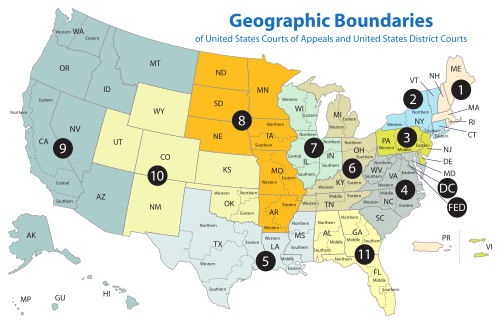
United States attorneys are officials of the U.S. Department of Justice who serve as the chief federal law enforcement officers in each of the 94 U.S. federal judicial districts. Each U.S. attorney serves as the United States' chief federal criminal prosecutor in their judicial district and represents the U.S. federal government in civil litigation in federal and state court within their geographic jurisdiction. U.S. attorneys must be nominated by the president and confirmed by the Senate, after which they serve four-year terms.
Contents
- History and statutory authority
- Appointment
- United States attorneys controversy
- History of interim U.S. attorney appointments
- Role of U.S. attorneys
- Executive Office for United States Attorneys
- List of current U.S. attorneys' offices
- Defunct U.S. attorneys' offices
- See also
- Notes
- References
- External links
Currently, there are 91 U.S. attorneys and 2 vacancies in 94 district offices located throughout the United States, Puerto Rico, the U.S. Virgin Islands, Guam, and the Northern Mariana Islands. One U.S. attorney is assigned to each of the judicial districts, with the exception of Guam and the Northern Mariana Islands, where a single U.S. attorney serves both districts. Each U.S. attorney is the chief federal law enforcement officer within a specified jurisdiction, acting under the guidance of the United States Attorneys' Manual . [1] They supervise district offices with as many as 350 assistant U.S. attorneys (AUSAs) and as many as 350 support personnel. [2]
U.S. Attorney's Offices are staffed mainly by assistant U.S. attorneys (AUSA). Often colloquially called "federal prosecutors", assistant U.S. attorneys are government lawyers who act as prosecutors in federal criminal trials and as the United States federal government's lawyers in civil litigation in which the United States is a party. In carrying out their duties as prosecutors, AUSAs have the authority to investigate persons, issue subpoenas, file formal criminal charges, plea bargain with defendants, and grant immunity to witnesses and accused criminals. [3]
U.S. attorneys and their offices are part of the Department of Justice. U.S. attorneys receive oversight, supervision, and administrative support services through the Justice Department's Executive Office for United States Attorneys. Selected U.S. attorneys participate in the Attorney General's Advisory Committee of United States Attorneys.

